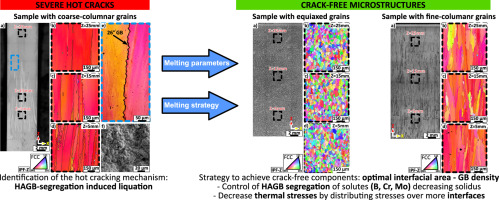当前位置:
X-MOL 学术
›
Acta Mater.
›
论文详情
Our official English website, www.x-mol.net, welcomes your
feedback! (Note: you will need to create a separate account there.)
Atomic-scale grain boundary engineering to overcome hot-cracking in additively-manufactured superalloys
Acta Materialia ( IF 8.3 ) Pub Date : 2019-09-01 , DOI: 10.1016/j.actamat.2019.07.041 Paraskevas Kontis , Edouard Chauvet , Zirong Peng , Junyang He , Alisson Kwiatkowski da Silva , Dierk Raabe , Catherine Tassin , Jean-Jacques Blandin , Stéphane Abed , Rémy Dendievel , Baptiste Gault , Guilhem Martin
Acta Materialia ( IF 8.3 ) Pub Date : 2019-09-01 , DOI: 10.1016/j.actamat.2019.07.041 Paraskevas Kontis , Edouard Chauvet , Zirong Peng , Junyang He , Alisson Kwiatkowski da Silva , Dierk Raabe , Catherine Tassin , Jean-Jacques Blandin , Stéphane Abed , Rémy Dendievel , Baptiste Gault , Guilhem Martin

|
There are still debates regarding the mechanisms that lead to hot cracking in parts build by additive manufacturing (AM) of non-weldable Ni-based superalloys. This lack of in-depth understanding of the root causes of hot cracking is an impediment to designing engineering parts for safety-critical applications. Here, we deploy a near-atomic-scale approach to investigate the details of the compositional decoration of grain boundaries in the coarse-grained, columnar microstructure in parts built from a non-weldable Ni-based superalloy by selective electron-beam melting. The progressive enrichment in Cr, Mo and B at grain boundaries over the course of the AM-typical successive solidification and remelting events, accompanied by solid-state diffusion, causes grain boundary segregation induced liquation. This observation is consistent with thermodynamic calculations. We demonstrate that by adjusting build parameters to obtain a fine-grained equiaxed or a columnar microstructure with grain width smaller than 100 $\mu$m enables to avoid cracking, despite strong grain boundary segregation. We find that the spread of critical solutes to a higher total interfacial area, combined with lower thermal stresses, helps to suppress interfacial liquation.
中文翻译:

克服增材制造高温合金热裂纹的原子级晶界工程
关于导致不可焊接镍基高温合金增材制造 (AM) 部件产生热裂纹的机制仍存在争议。对热裂纹的根本原因缺乏深入了解是设计用于安全关键应用的工程部件的障碍。在这里,我们采用近原子尺度的方法来研究粗晶柱状微观结构中晶界的组成装饰细节,这些部件由不可焊接的镍基高温合金通过选择性电子束熔化制成。在 AM 典型的连续凝固和重熔过程中,晶界处 Cr、Mo 和 B 的逐渐富集,伴随着固态扩散,导致晶界偏析引起液化。该观察结果与热力学计算一致。我们证明,尽管存在强烈的晶界偏析,但通过调整构建参数以获得晶粒宽度小于 100 $\mu$m 的细晶等轴或柱状微观结构,可以避免开裂。我们发现,临界溶质扩散到更高的总界面面积,加上较低的热应力,有助于抑制界面液化。
更新日期:2019-09-01
中文翻译:

克服增材制造高温合金热裂纹的原子级晶界工程
关于导致不可焊接镍基高温合金增材制造 (AM) 部件产生热裂纹的机制仍存在争议。对热裂纹的根本原因缺乏深入了解是设计用于安全关键应用的工程部件的障碍。在这里,我们采用近原子尺度的方法来研究粗晶柱状微观结构中晶界的组成装饰细节,这些部件由不可焊接的镍基高温合金通过选择性电子束熔化制成。在 AM 典型的连续凝固和重熔过程中,晶界处 Cr、Mo 和 B 的逐渐富集,伴随着固态扩散,导致晶界偏析引起液化。该观察结果与热力学计算一致。我们证明,尽管存在强烈的晶界偏析,但通过调整构建参数以获得晶粒宽度小于 100 $\mu$m 的细晶等轴或柱状微观结构,可以避免开裂。我们发现,临界溶质扩散到更高的总界面面积,加上较低的热应力,有助于抑制界面液化。















































 京公网安备 11010802027423号
京公网安备 11010802027423号